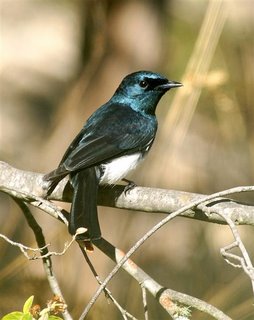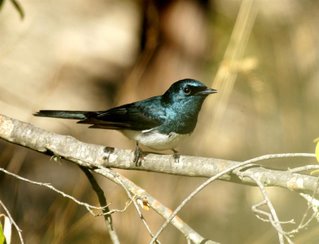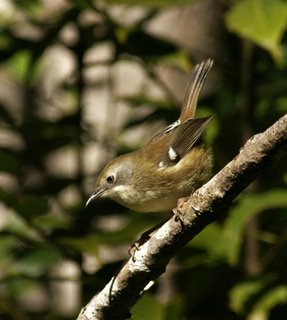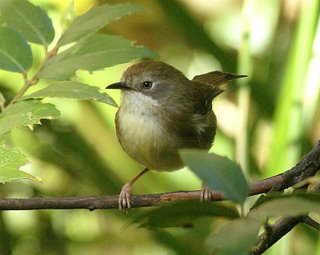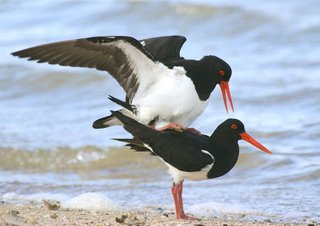 After reading a recent newspaper article about the Chauncy Vale Reserve having been enlarged, I thought a visit might be in order. I hadn't visited this reserve in over 10 years, but recalled seeing such species as Peregrine Falcon and Bassian Thrush there, to name only two. This reserve is situated in Bagdad (the Tasmanian one!), and is accessed down the lane by the sandstone church in the centre of the township. My first impressions were that, like so much of the state, it was extremely dry and the bush looked 'distressed'. Certainly not the fairly lush surrounding of my last visit. So the sign at the last gate saying "No Smoking", shouldn't have brought a wry smile to my face!. Actually I had the thought that maybe it should have added "Turn Off Mobile Phones"--now there's a thought. In the event I had the reserve to myself. I kept mainly to the track along the near dry creek bed, but did climb the hill to Guvy's Lagoon--unfortunately bone dry, but the presence of a male Flame Robin hawking over the area, calling Satin Flycatchers , Shining Bronze Cuckoos and scolding thornbills, made up for that. On my return to the valley floor, I was greeted by the calling of a number of Olive Whistlers, the predominant whistler in this area. I've been trying for sometime to get shots of this species, and although I've seen a good few, this proved to be the first time I've actu
After reading a recent newspaper article about the Chauncy Vale Reserve having been enlarged, I thought a visit might be in order. I hadn't visited this reserve in over 10 years, but recalled seeing such species as Peregrine Falcon and Bassian Thrush there, to name only two. This reserve is situated in Bagdad (the Tasmanian one!), and is accessed down the lane by the sandstone church in the centre of the township. My first impressions were that, like so much of the state, it was extremely dry and the bush looked 'distressed'. Certainly not the fairly lush surrounding of my last visit. So the sign at the last gate saying "No Smoking", shouldn't have brought a wry smile to my face!. Actually I had the thought that maybe it should have added "Turn Off Mobile Phones"--now there's a thought. In the event I had the reserve to myself. I kept mainly to the track along the near dry creek bed, but did climb the hill to Guvy's Lagoon--unfortunately bone dry, but the presence of a male Flame Robin hawking over the area, calling Satin Flycatchers , Shining Bronze Cuckoos and scolding thornbills, made up for that. On my return to the valley floor, I was greeted by the calling of a number of Olive Whistlers, the predominant whistler in this area. I've been trying for sometime to get shots of this species, and although I've seen a good few, this proved to be the first time I've actu ally got to photograph one. They do seem to call mostly from within dense shrubbery. Fortunately, this one (top right) spent a while in a mainly open, old, lichen covered acacia area with young gums growing through it, giving me at least a show of photographing it. Predictably, it wasn't long before it disappeared back into the dense cover along the creek line. After spending some time on the Whistler, I crossed the creek and walked back towards the entrance, passing largely stagnant pools. Stagnant or not, the presence of water attracted several species, including family groups of Strong-billed Honeyeaters and 5 or 6 male Satin Flycatchers. Farther downstream were family groups of Scarlet, Flame and Dusky Robins, several very territorial Yellow-throated Honeyeaters and numerous Green Rosellas. A satisfying walk, although I had only seen a small part of the reserve, but it had whetted my appetite for another visit, soon. As I drove out, there were at least 4 Pallid Cuckoos hawking from the power line. I say hawking , but they were actually pouncing on insects on the ground. At one stage I noticed a Richard's Pipit give a "shivering" wing display, apparently aimed at one of the Pallids. I'm not aware that they are parisitized by Pallids, but I really don't know. I suspect that their hawklike appearance was just too much for the Pipit. Nearer the main road, in very dry bare paddocks and on the roadway, were numerous Richard's Pipits, many of them juveniles, one of which I photographed as shown at left. All in all well worth a visit. [By the way, there is a $2 a head entrance fee by way of an honesty box at the gate.]
ally got to photograph one. They do seem to call mostly from within dense shrubbery. Fortunately, this one (top right) spent a while in a mainly open, old, lichen covered acacia area with young gums growing through it, giving me at least a show of photographing it. Predictably, it wasn't long before it disappeared back into the dense cover along the creek line. After spending some time on the Whistler, I crossed the creek and walked back towards the entrance, passing largely stagnant pools. Stagnant or not, the presence of water attracted several species, including family groups of Strong-billed Honeyeaters and 5 or 6 male Satin Flycatchers. Farther downstream were family groups of Scarlet, Flame and Dusky Robins, several very territorial Yellow-throated Honeyeaters and numerous Green Rosellas. A satisfying walk, although I had only seen a small part of the reserve, but it had whetted my appetite for another visit, soon. As I drove out, there were at least 4 Pallid Cuckoos hawking from the power line. I say hawking , but they were actually pouncing on insects on the ground. At one stage I noticed a Richard's Pipit give a "shivering" wing display, apparently aimed at one of the Pallids. I'm not aware that they are parisitized by Pallids, but I really don't know. I suspect that their hawklike appearance was just too much for the Pipit. Nearer the main road, in very dry bare paddocks and on the roadway, were numerous Richard's Pipits, many of them juveniles, one of which I photographed as shown at left. All in all well worth a visit. [By the way, there is a $2 a head entrance fee by way of an honesty box at the gate.]






